Fiido Air Carbon E-Bike Review | Fetching & Featherlight
A sporty, crazy lightweight city e-bike packed with tech and value, the Air brings affordable carbon fiber with great handling to the masses.
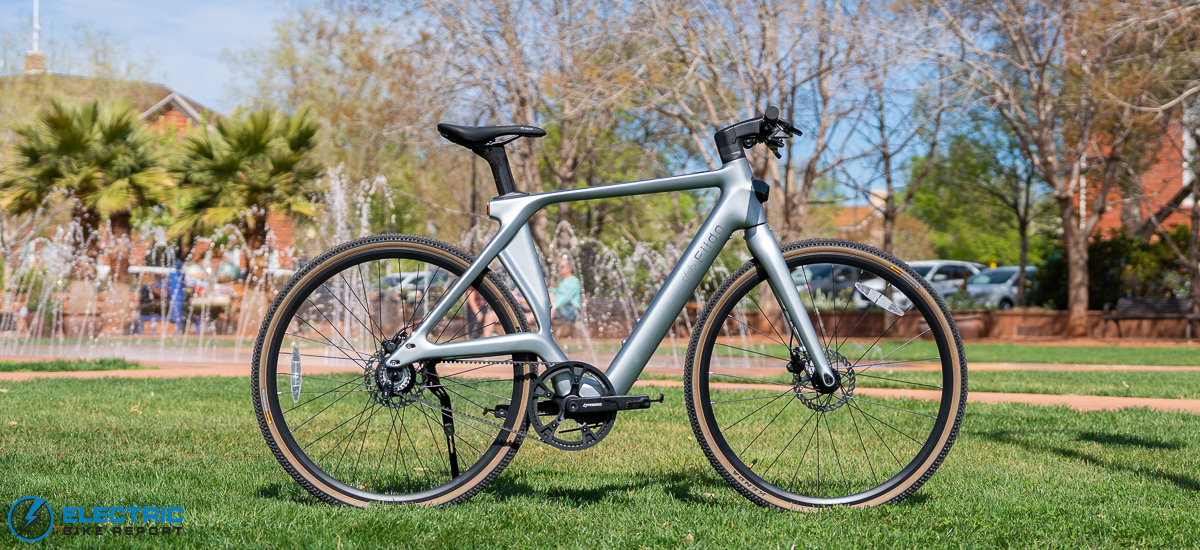
There’s a good reason why many high-end, performance-oriented bikes are made from carbon fiber. This reinforced polymer material is lightweight and strong but not completely rigid. When used correctly, carbon fiber bikes typically have quick acceleration, a high degree of agility, and a comfortable ride.
When used incorrectly, they sound cool and look nice, but that’s about it.
The term “carbon fiber” has been an increasingly popular buzzphrase in the e-bike industry in recent years, with some brands going out of their way to use the material simply to draw attention. In contrast with these cases, I’m happy to report that the Fiido Air is carbon fiber done right.
Case in point: not only did the Air impress us with its overall design and ride feel, it’s the most affordable carbon fiber e-bike we’ve tested (at the time of writing) with a price point under $2k.
Fiido upped the value factor even more with a handful of uncommon tech elements, including a fingerprint reader and an interface reminiscent of those we’ve seen on bikes 3x its price. The brand even includes a smartwatch that pairs with the bike, giving riders a novel way of operating its functions and monitoring their speed and battery charge level.
On paper, all of that might sound too good to be true. We tested the Air’s performance in our series of standardized Speed, Range, Hill, and Brake Tests to find out if that was the case—read all about our findings in the full review below!
 Pros
Pros- The Air’s value is insane! It offers full carbon fiber construction combined with cool integrated tech—and a smart watch—for under $2k!
- At roughly 33 lbs, this is one of the lightest e-bikes we’ve tested. Its low weight makes it quick to get up to speed, impressively agile, and easy to carry or transport.
- It rides just like a non-electric bike with responsive power, thanks to the combination of a 250W motor and torque sensor.
- It includes cool security features, like a fingerprint sensor that can be set up with multiple user profiles, an auto-unlock feature, and more.
- With two pedal assist levels and a low-maintenance, single-speed drivetrain, this bike is simple to ride and own (once the tech is figured out).
- Carbon fiber construction absorbs some vibrations, so the Air’s ride is more comfortable than a rigid alloy frame.
- The bike is simple and spartan to start, but commuter-friendly accessories like fenders, a kickstand, and side mirrors can be purchased separately.
- The Air includes knobby gravel-ready tires, giving it enough versatility for light off-road adventures.
- Visually, it’s one of the cleanest and most unique designs we’ve ridden. There aren’t likely to be too many others out in the wild.
- Thoughtful details, like the Allen key holder at the bottom of the frame, give a boost to the bike’s already awesome ride quality.
 Cons
Cons- The bike is set up well for the EU market, but its speed of 16 mph is limiting for the US crowd. We’d like to see a version with faster speeds and more power for hills.
- We had to restart the process a few times when attempting to pair the bike, the watch, and the app. There’s a bit of a learning curve when making sure the three elements play nicely together.
- For added safety, we’d prefer a taillight that also functions as a brake light.
- Battery: DMEGC 208.8Wh
- Display: None
- Motor: Mivice M070 250W
- Headlight: Integrated LED
- Taillights:Integrated LED
- Pedal Assist: Normal mode, Sport mode
- Claimed Range: 37.49 Miles (Normal), 32.27 Miles (Sport)
- Throttle:N/A
- App:Fiido App
- UL Certification:UL 2849 Certified, UL 2271 Certification Coming Soon
- Claimed weight: 30.3 lbs
- Tested Weight: 32.7 lbs
- Rider height range: 5’4”-5’9” (M), 5’7”-6’3” (L), 6’1”-6’9” (XL)
- Total payload capacity: 264 lbs
- Brakes:Tektro HD-M275N Hydraulic Disc Brakes
- Fenders:Available Separately
- Fork:Carbon fiber through axle fork (axle diameter 15mm) with 100mm opening width
- Frame: 700C carbon fiber frame
- Drivetrain:Single-Speed, Gates CDX 60T Chainring, Gates CDC 22T Rear Cog, Gates CDN Belt
- Grips: TPR non-slip handle grip (Length: about 130mm)
- Saddle: VELO vacuum full-fit saddle, Carbon fiber aero seatpost (Length: M-355mm; L-385mm; XL-415mm)
- Handlebar: Carbon fiber (Length: 640mm, Maximum diameter: 31.8mm, Minimum diameter: 22.2mm)
- Kickstand: Available Separately
- Pedals: Aluminum Platform
- Tires: KENDA 27.6*1.57
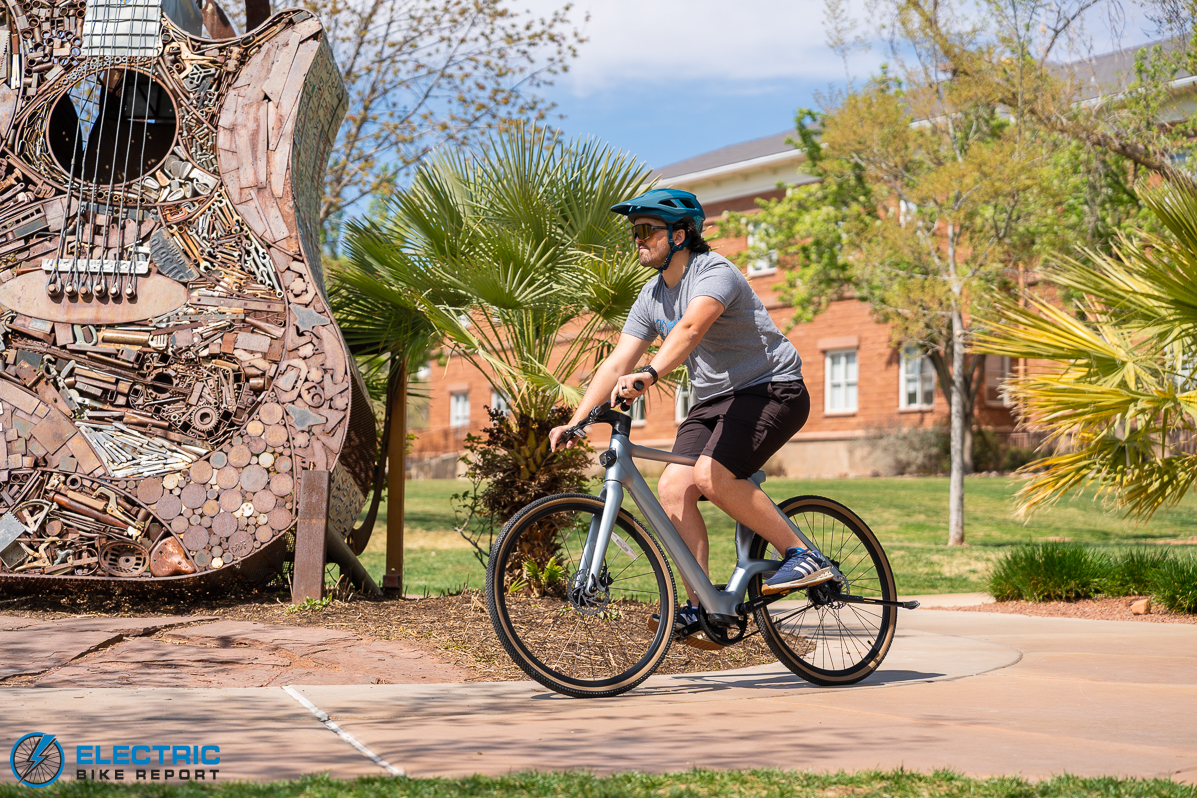
City bikes, such as the Fiido Air, are ideal for second- or third-story apartment dwellers commuting to work or navigating across campus.
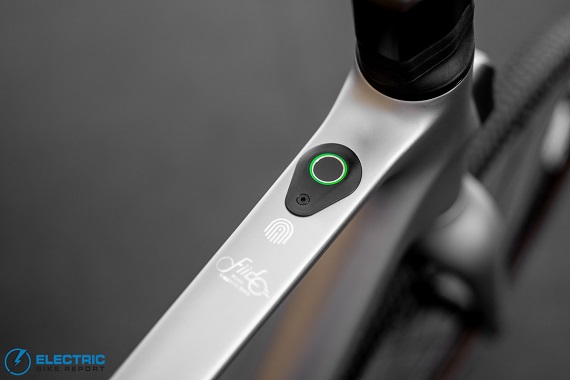
Instead of a display, the Air features an intuitive and cool fingerprint reader with a light ring to indicate assist level and charge.
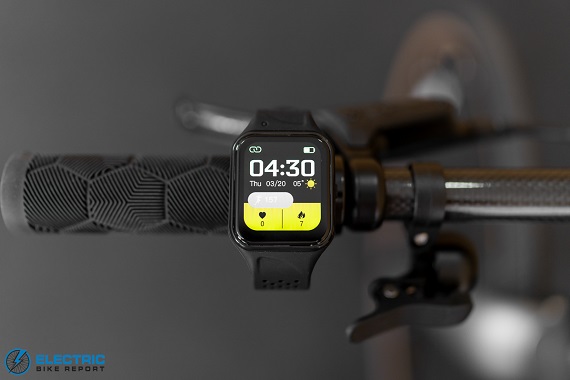
The included smartwatch can be used to operate the bike, track health & fitness data, and, of course, tell time.
Fiido Air Review: Speed Test
In our Speed Test, my goal was simply to see how fast the Fiido Air could be in each of its pedal assist settings. The bike keeps things easy with only two power levels, Normal Mode and Sport Mode, with each being indicated by a colored light ring around the Air’s fingerprint reader.
To test the bike, I pedaled along a flat segment of our local multi-use paths and used a third-party speedometer app to track my speed since the Air does not include an onboard display. My results are shown in the graph above.
As a company with a larger base in Europe, Fiido limited the Air to an EU-approved 25 km/h or 15.5 mph. Riders can exceed this limit with leg power, and the Air’s lightweight frame makes this easier than most e-bikes, but I held back to avoid exceeding the motor’s output as much as possible.
The graph of my data shows that the bike was able to reach (and slightly exceed) its maximum pedal-assisted speed in both Normal and Sport modes, and that the difference between the two settings was negligible.
With a 250W rear hub motor and a torque sensor, the Air is clearly geared toward cyclists who enjoy an active pedaling experience. The motor itself was helpful up to the bike’s maximum speed, delivering power responsively and reacting to how much pressure I applied to the pedals, without feeling like it was overtaking my effort, just adding to it.
Pedaling felt somewhat easier in Sport mode than Normal mode, where the Air felt a bit more natural (like an analog bike), so there did seem to be a slight difference in power output. However, the bike’s limited speed didn’t give the motor enough room to reflect that disparity in our test.
The Air’s low weight allows it to feel faster than it is, but there’s no avoiding the fact that 16 mph is somewhat limiting. Considering EU standards, the Fiido Air is set up well for the European market, but I think it’s reasonable to expect that many riders here in the US will want to ride faster.
As such, we’d like to see a US version of the Air with a higher speed limit that would put it on par with most similar models we’ve tested. A full Class 1 option with a 20 mph max speed would be a great starting place, though personally, I think the bike would do well as a faster Class 3 with pedal assist up to 25 or 28 mph.
Limited speed aside, I thoroughly enjoyed the Air’s quick acceleration and responsive pedal assist system. Overall, I think the bike did a decent job in this test, even if there is some room for improvement.
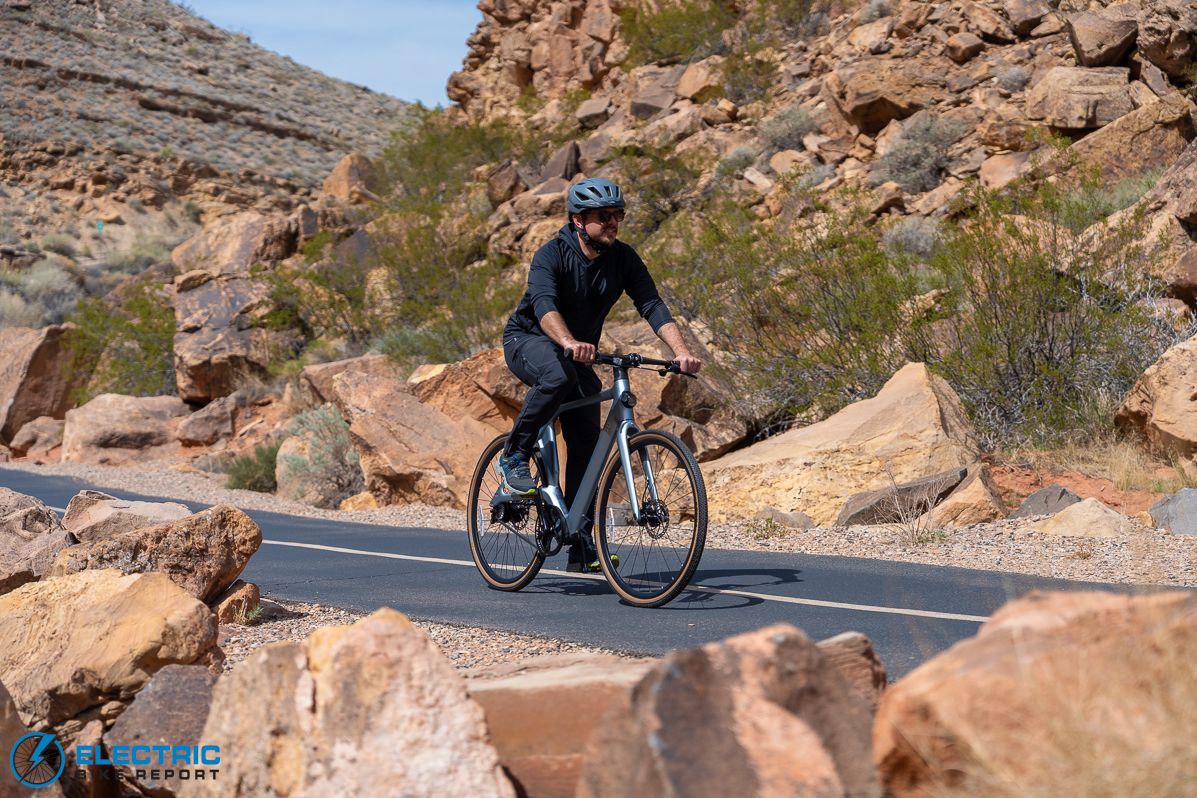
A carbon fiber frame, fork, handlebar, and seatpost help the Air to feel light, nimble, and much faster than it is.
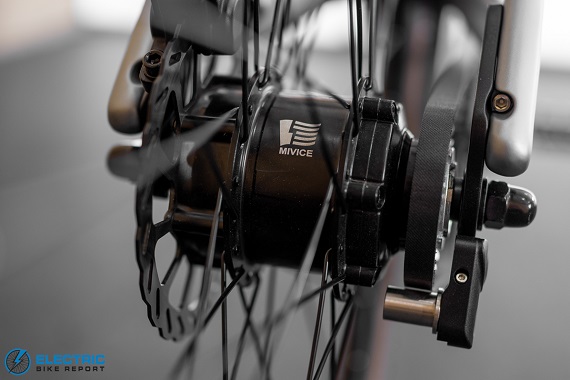
The bike’s Mivice 250W rear hub motor produces 35Nm of torque and 388W of peak power.
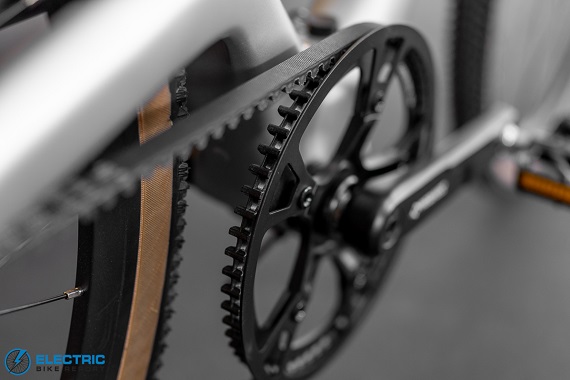
The single-speed Gates Carbon drive can be somewhat limiting on hills, but it is clean, long-lasting, and low-maintenance.
Fiido Air Review: Range Test
The Fiido Air’s motor is powered by an internal 209 Wh battery concealed in the bike’s down tube. We tested the Fiido Air’s range and motor/battery efficiency using the process explained in the graphic above. Our results are compared with Fiido’s advertised range and the results we’ve measured from similar city/urban e-bikes we tested previously.
Both of our range results are right around average for a city e-bike based on similar models we’ve tested. The category averages 23 and 43.6 miles, so the Fiido Air went slightly further in both tests, with a maximum difference of under 2 miles. With such similarity in results, our test shows that the Air is generally specced well and able to keep pace with its peers.
The Air’s results were particularly impressive considering that its battery is significantly smaller than average for the city e-bike category. Similar models we’ve tested had an average of 342 Wh, over 60% higher than Fiido’s battery. This suggests that the Air’s low weight, which is about 10 lbs below the category average, helped to counteract its smaller-than-average battery.
As my Speed Test results indicated, there was not much difference between the Air’s two assist levels, which was further backed up by Fiido’s own range test results.
The brand’s test rider, who weighed 176 pounds, went 32.3 and 37.5 miles. This difference of only about 5 miles caught my attention, as it is much less of a gap than we typically see between tests using a bike’s highest and lowest power levels. It’s also much narrower than the difference between our results, though not without good reason.
The difference seems to be related to rider weight, further reinforcing just how much that factor can affect a bike’s range—especially one that weighs so little without a rider.
I personally performed our Range Test using Sport Mode, and my weight of roughly 190 lbs is about 15 lbs heavier than Fiido’s test rider. Our rider for the Normal mode, Asha, weighs around 160 pounds, which is about 15 pounds lighter than Fiido’s rider.
Fiido’s results fell almost perfectly between those that Asha and I recorded on the bike, which makes sense considering that their test rider was also between Asha and me in terms of weight.
Regardless of which power level riders use, we expect most should be able to cover a long round-trip commute or a few short ones on a single charge. Based on my experience and the minimal difference between assist settings, however, I recommend sticking to the lower power level to maximize the Air’s range.
A few final details: the included 2-amp charger should be able to recharge the battery in about 3 hours. Additionally, Fiido offers an external range extender for those who need more than the internal battery can offer. This second battery is priced around $250 and is claimed to be able to double the bike’s range, though we feel it did well with its standard power supply and do not expect most riders will need the extra power.
Fiido Air Review: Hill Test
We tested the Fiido Air’s climbing ability using our standard process described above, though with no throttle, we only needed a single pedal test at Hell Hole Trail in Sport mode. Our test rider, Justin, commented that the Air was “still better than a regular bike” when pedaling up the paved path with some effort.
Even the best city and urban e-bikes tend to be on the slower side in this test, as they generally feature relatively low-power motors that encourage active pedaling. With that in mind, the Air’s result of 2:14 at 8.1 mph was roughly 22 seconds slower than average for the city e-bike category; the bikes used for comparison averaged 1:52.
The Air showed that it can effectively make a tough climb easier than a rider would experience on a non-electric bike, but it had two main elements working against it in this test: its single-speed drivetrain and uncommonly low motor output.
Single-speed drivetrains are inherently limiting when it comes to pedaling uphill, as they must balance their gearing between climbing and pedaling efficiently on flat ground. If it is set up to pedal uphill too easily, the gearing will feel loose and ineffective on flats, and vice versa. Based on previous experience, the Air’s gearing is balanced about as well as it can be.
In terms of motor output, the Air’s motor skews toward the light side with a peak of just 388W and 35 Newton-meters (Nm) of torque. Both of these figures are among the lowest we’ve seen for the city style, which already tends to favor a natural feel. For perspective, other bikes we’ve tested averaged 587W of peak power and 44 Nm of torque.
As further evidence of the slight difference in power between the Air’s two assist levels, I tested the bike in both modes at our secondary Hill Test location, called Pilot Hill. My results in each mode differed by only one second and 0.1 mph, suggesting that both modes reach the bike’s maximum output with neither having a real advantage over the other.
To add to what I stated previously about wanting a US version of the bike with higher speeds, we think a more powerful motor would be appropriate to help offset the limitations of the drivetrain, especially for those who live in hillier areas.
As it is, the Air rides extremely well on the flat and seems to be optimized for cities without many hills, but it can do the job of helping you pedal uphill as long as you don’t mind a bit of a workout.
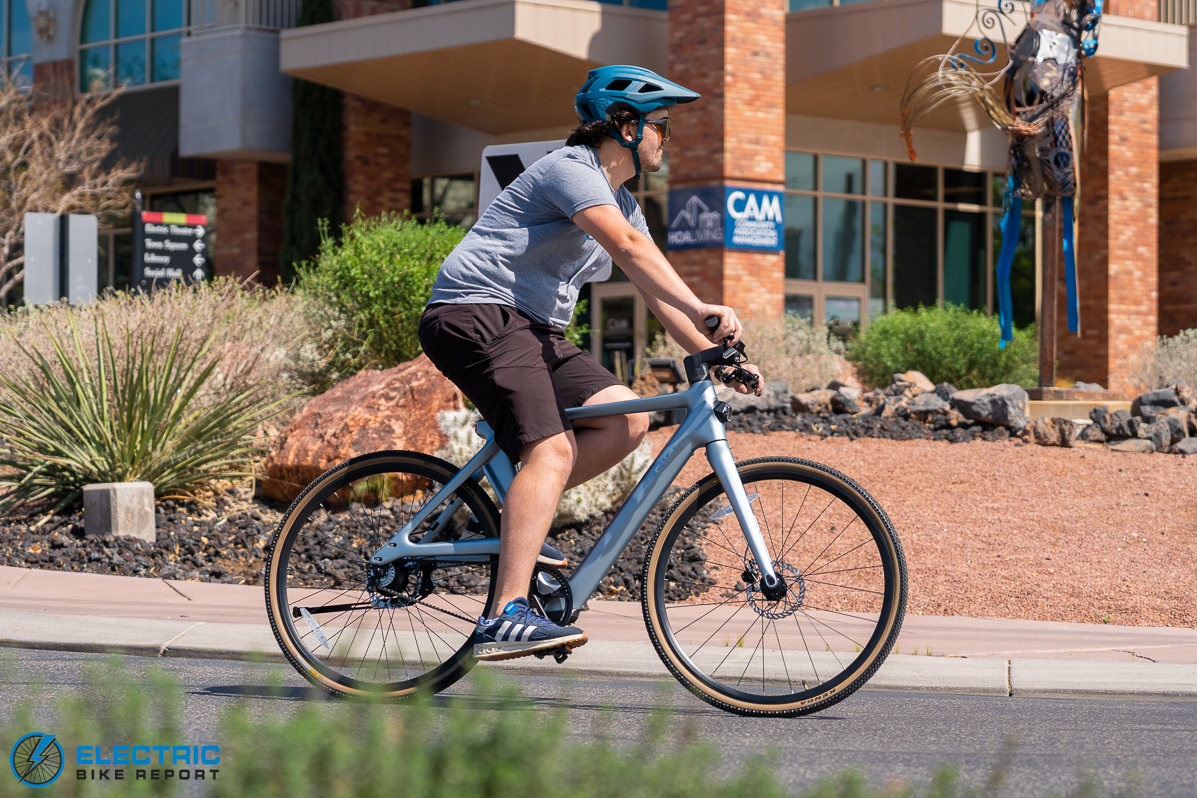
It’s hard to deny that the Air’s seamless carbon fiber frame is sleek, unique, and eye-catching.
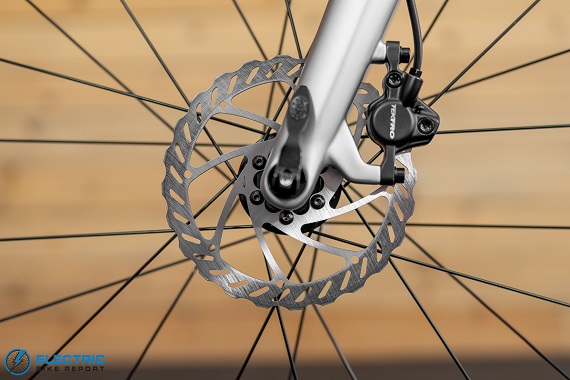
The Tektro hydraulic disc brakes pair 2-piston calipers with 160mm rotors.

With no shifter, the bike’s brake levers are the only handlebar-mounted controls.
Fiido Air Review: Brake Test

Fiido equipped the Air with the Tektro HD-M275n hydraulic disc brake system, with 2-piston calipers and 160mm rotors. We tested its stopping power using the method described above, with an average result of 25’2”. This result is just under two feet longer than the city category average of 23’3”, at the time of writing.
In practice, Griffin and I agreed that the Air’s brakes felt great, which lines up well with our previous experiences with this particular brake system. The M275n unit typically has very solid results, but this was a bit of an unusual case where the Air’s test results didn’t quite line up with our expectations or the bike’s actual feel.
I’m quoting Griffin here with his permission: after performing the brake test, he said, “This might be a case of a heavy guy on a super lightweight bike.” Translated, this means that his inertia seemed to keep him moving longer than usual. Taken a step further, it’s possible that a rider under Griffin’s roughly 230 lbs might have better results.
In my personal testing, the bike did feel like it wanted to skid for longer than I expected, which seemed to be a combination of its lightweight frame and knobby tires. Based on my experience, I recommend practicing with braking once the bike arrives so you know what to be prepared for.
Overall, I think the Air’s braking performance felt safe, even if we hoped for a shorter stopping distance. I like that the bike has an integrated LED headlight and taillight for visibility in low-light conditions, but to increase its safety factor when sharing the road with motorists, I would like to see it include a tail light that functions as a brake light in the future.
Owners who want to shorten the bike’s stopping distance might wish to swap the tires to a softer compound with more grip on paved surfaces, though this has the tradeoff of causing tires to wear faster.
Otherwise, we consider the Air to be set up well spec-wise, so we don’t feel the need to recommend any changes to the brand.
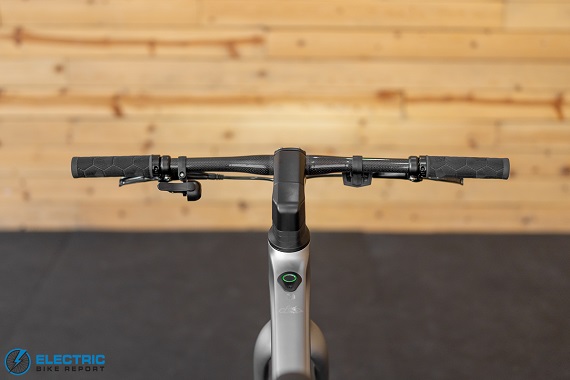
The carbon fiber handlebars measure 640 mm in width.

We loved how seamlessly the LED lights integrate into the frame!
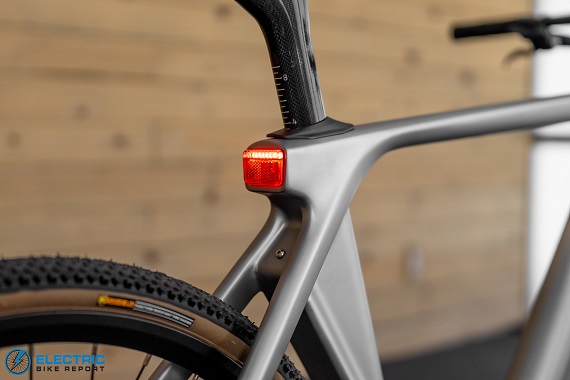
The integrated taillight looks great, but we wish it also had brake light functionality.
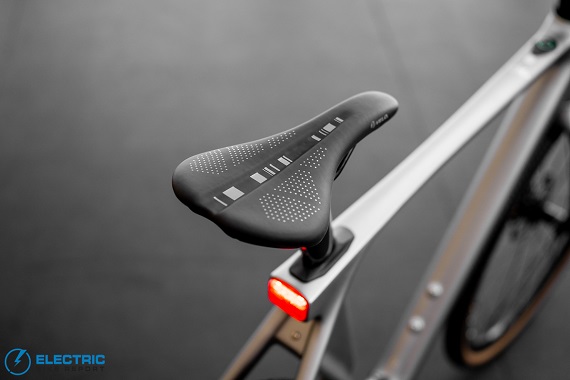
I found the bike’s saddle appropriately slim but supportive and comfortable.
Fiido Air Review: Ride Quality
Ride Quality is a complex subject encompassing many areas of a bike’s feel and operation; in essence, it’s a measure of the overall user experience. Strap in for a long read, as this section will likely form the bulk of my review; the Fiido Air might look simple, but it has a surprising amount of depth when considering the app and the included smartwatch.
Starting off with the basics, Fiido offers the Air in three frame sizes at the time of writing: a Medium, a Large, and an XL. The Medium frame is intended for riders from 5’4” to 5’9”, while the Large fits those between 5’7” and 6’3”, leaving the XL for cyclists sized from 6’1” to 6’9”.
At 5’11”, I am right in the middle of the recommended height range for the Large frame we tested. The bike’s proportions felt great; its saddle’s 4” range of adjustment allowed me to set a comfortable leg extension. Its reach felt on the longer side, placing me at a relatively aggressive forward lean with my weight balanced between the handlebars and saddle.
I typically don’t enjoy e-bikes with such an aggressive feel, but the Air felt comfortable throughout my testing. Its slim, performance-oriented saddle was supportive and not too firm. Its rubber grips were soft and squishy, and its pedals were relatively small but grippy and sturdy.
My only real complaint about comfort is minor. Our test bike included a kickstand that doesn’t come standard (but can be added at purchase, like the optional fenders and side mirrors). With a US men’s size 12 shoe, I often found my left heel hitting the kickstand mount, though this could be avoided with mindful foot placement.
Thanks to the bike’s carbon fiber frame, it picked up speed quickly and felt extremely agile and maneuverable while moving. Cornering felt crisp and predictable with my weight half on the bars, thanks to the bike’s rigid fork.
Speaking of the rigid frame, it’s important to note that carbon fiber has a “softer” feel than aluminum or steel because it’s slightly more flexible. This shock-absorbing property means that the Air’s ride felt far less jarring when riding over uneven surfaces than a typical alloy frame; as someone who prioritizes comfort, the ride was appreciably smooth and enjoyable.
The Air includes 700x40c knobby tires from Kenda, which serve to make the bike capable of light off-roading. They performed well and provided great traction when I tested the bike on short sections of dirt and gravel paths. I think the Air will likely satisfy gravel riders who prefer bikes with flat handlebars to the drop bars typical of gravel-specific or road bikes.
Before moving on, I want to mention the many positive features of the Air’s single-speed drivetrain. While somewhat limiting when pedaling uphill, this setup is extremely low maintenance; the Gates Carbon belt is rated to last at least twice as long as a chain. It’s also much cleaner, as it does not require grease—a feature many commuters in business attire will appreciate.
Now for the more technical stuff: the bike’s user interface, the Fiido app, and the smartwatch.
Starting with the fingerprint reader and light ring that make up the bike’s interface, this system has a learning curve, though overall, I found it intuitive.
Once a fingerprint is set up through the Fiido app—a process which is similar to older smartphones, where the user must perform a series of thumb/finger presses with some slight rotation until registered—a long press of 3 seconds will turn the bike on or off.
A single tap will cycle through the bike’s assist levels (Sport mode and the zero-power level are both purple, which is somewhat confusing), while a double tap will activate or deactivate the lights.
The colored light ring around the fingerprint reader is used to indicate the battery’s charge level. At 60% or above, it shows green, then switches to blue until 40% remains, whereupon it will show red.
As a sidenote, I learned through trial and error that, should the bike’s Bluetooth pairing mode be needed, it’s essential to use a finger that isn’t paired with the bike to avoid simply turning it off.
This leads me to my next point: the electronic ecosystem between the bike, the app, and the smartwatch. Each of these elements can only be connected to one of the others at a time, so properly setting up the connections is essential.
I found this to be somewhat of a stumbling block, which I attribute partially to my own eagerness (I jumped in without reading the instructions) and also to some lack of clarity in the instructions. I had to restart the process a few times and discover some details as I went; I recommend not connecting the app and the watch to avoid some frustration.
Diving into the app, I found that it’s a useful and relatively robust feature. In addition to serving as a control panel that can turn the bike and/or its lights on and off, it can track ride data and link to your preferred navigation app, in addition to hosting a social-media-like feature and providing access to many of the bike’s controls.
The app can serve as a display with a variety of customizable ride data modules. If you prefer to keep track of how many feet of elevation you’ve gained over your ride instead of the bike’s maximum speed, you can choose what information the display mode presents.
It is also used to set up fingerprint profiles and choose which security measures are employed. For example, when the Smart Unlock feature is activated, the bike will automatically turn on when a user wearing the smartwatch approaches it. Additionally, watch control can be completely deactivated, leaving only the smartphone holder with the ability to use the bike.
Finally, let’s dive into the smartwatch itself. It ships already paired with the Air (an aspect I missed when trying to set up connections), so that when the bike is turned on, it can switch between bike and watch modes.
When in bike mode, it displays a speedometer, a bar-based battery charge indicator, and the current pedal assist setting. It can also be used to activate lights or switch between the bike’s Normal, Sport, and zero-power modes.
When in watch mode, it shows the time, the wearer’s heart rate and step count, and the number of calories burned. Users can select from a variety of faceplate appearances and access a variety of apps, including weather (though I couldn’t figure out how to change my location), an exercise-tracking Sports Mode, a timer function, and a relaxing breathing app, among others.
If connected to a smartphone, it can also be used to see notifications, control music, access the phone’s camera, and a variety of other features.
Overall, I think the smartphone is a great alternative to an onboard display for those who prefer a minimalistic look, as the only option for most similar e-bikes without a display is a bulky phone mount (though, of course, this is still an option).
In conclusion, the Fiido Air’s ride quality is a solid step or two above the norm, largely due to its carbon fiber construction and integrated tech. It clearly has a learning curve (be sure to read the instructions first!), but once set up properly, I don’t expect most users to have much trouble.
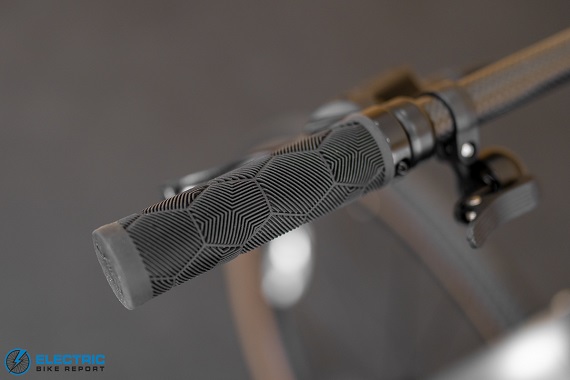
The low-durometer rubber grips felt great and helped offset the relatively aggressive riding position.
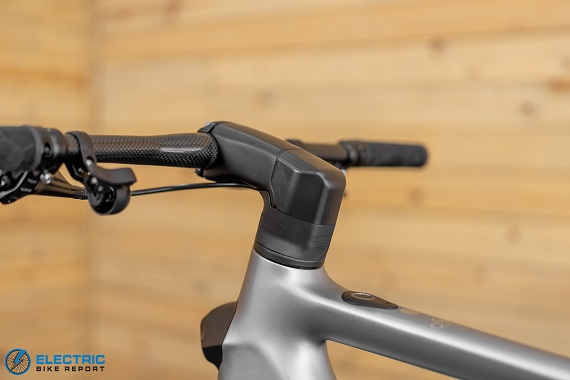
The bike’s cables are routed through the stem and headset; this looks fantastic but can add time and cost to maintenance.
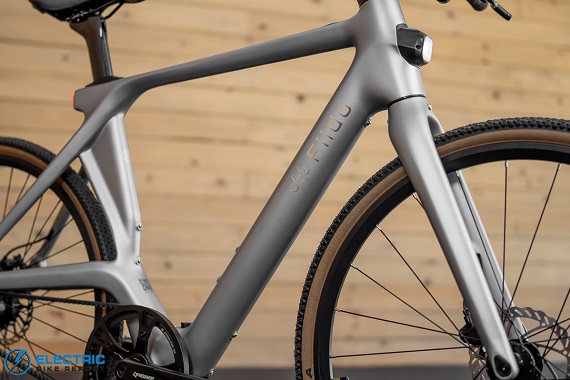
The Air earned a Red Dot Design Award for its clean and smooth styling.
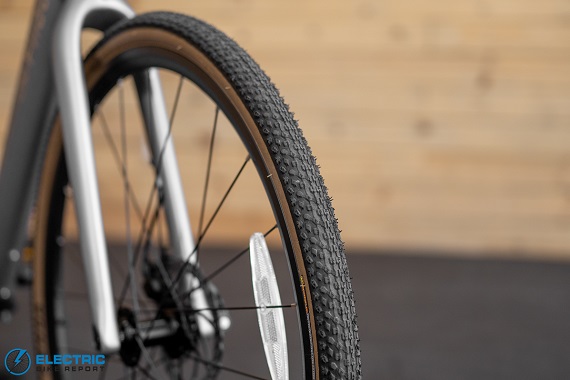
Knobby tires allow for some light off-roading on dirt or gravel paths.
Fiido Air Review: Summary / Where to Buy
Innovation is something I feel should be rewarded, especially considering that it comes with inherent risk. There is no guarantee that a given idea will work, no matter the investment of time, money, and/or energy.
In my experience, the Fiido Air is an unexpected—and extremely cool—combination of technology, high-end materials, and great design, regardless of the areas where it could be improved.
Compared with many similar city e-bikes we’ve tested, the Air had respectable range, but it fell somewhat behind in terms of its programming, braking performance, and overall power. It was also an excellent reminder that an e-bike is more than the sum of its parts, and that performance data is not always its most important element.
We have a short wishlist of desired improvements that include brake lights for increased safety, a more powerful motor for better climbing, higher speeds for mass appeal in the US market, and perhaps a more streamlined or self-explanatory setup process between pieces of technology.
Otherwise, however, the Fiido Air checks many of the essential boxes for a great city e-bike. It’s extremely lightweight and nimble, it offers a comfortable yet sporty ride, it features a responsive motor that promotes active pedaling, and delivers an impressive level of value. Its looks are the icing on the cake, and well-deserving of the Red Dot Design Award that it earned.
Based on this experience, I look forward to testing more e-bikes from Fiido in the future. For now, however, I’m happy to recommend the Air to riders seeking a high-tech, highly portable, and extremely unique e-bike for navigating city streets.
Happy Riding! Make sure to let us know if you have any questions or if you think we left anything out in this review of the Fiido Air down in our comments section.



